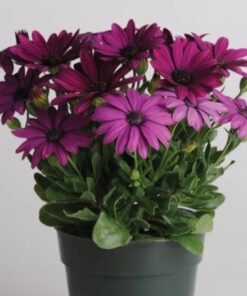Lisianthus Rosita Purple Rose hybrid seeds pack of 15-20 seeds Pelleted Imported
₹140.00
Out of stock
Email when stock available
Lisianthus Rosita Purple Rose Pelleted Seeds: The Elegant Flower Journey
Lisianthus, often called “Eustoma,” is a true showstopper with its delicate, ruffled petals and wide range of vibrant hues. Whether you’re growing them for the garden or for cut flowers, these beauties can seem a bit tricky at first glance, but the key to success lies in understanding how to handle pelleted seeds. These little gems are coated in a special layer to help them germinate more reliably, but getting them to bloom their best takes a little finesse. Let’s dive into the world of Lisianthus and unlock the secrets to growing them from pelleted seeds.
Lisianthus Rosita Purple Rose What Are Pelleted Seeds?
Pelleted seeds are coated with a layer of clay or other materials, which makes them easier to handle and sow. This coating improves the seed’s chances of successful germination by providing protection against environmental factors and ensuring more even moisture distribution. In the case of Lisianthus, this makes sowing much simpler because the seeds are tiny and a bit finicky without the pellet.
Step 1: Start Early (And Be Patient)
Lisianthus takes its sweet time to grow, so patience is a must. Start your seeds indoors about 10-12 weeks before your last frost date—this gives your plants the best chance of thriving when it’s time to move them outside. Keep in mind that Lisianthus can be slow to germinate, sometimes taking 2-3 weeks.
Tip: Use a seed-starting tray or small pots with good drainage, and use a seed-starting mix that’s light, airy, and well-draining.
Lisianthus Rosita Purple Rose Step 2: Prep Your Pelleted Seeds
Because these seeds are coated, they are a little more forgiving in terms of handling. But you’ll still want to sow them with care. Take a pinch of your pelleted seeds and gently press them into the surface of the soil—don’t bury them. You want them exposed just enough for light to penetrate. A thin layer of vermiculite or finely sifted soil over the top will help, but don’t overdo it.
Step 3: Provide Consistent Heat and Light
Lisianthus seeds need warmth to kickstart their growth. Keep the temperature between 70-75°F (21-24°C) for optimal germination. If you’re starting indoors, placing a seed heat mat underneath your trays can give the seeds just the right temperature boost. Once the seeds have sprouted, they’ll need plenty of light to grow strong and healthy.
A south-facing window or grow lights will do wonders. Aim for 12-14 hours of light per day, and be ready to adjust your setup as the seedlings grow taller. If you don’t give them enough light, they may become leggy and weak.
Lisianthus Rosita Purple Rose Step 4: Keep Soil Moist (But Not Wet!)
Moisture is key, but Lisianthus is finicky when it comes to too much water. Keep the soil lightly moist—not soggy—using a gentle spray or mist. A humidity dome or clear plastic cover can help keep moisture in and prevent the soil from drying out.
Step 5: Thin the Seedlings
Once your Lisianthus seedlings have sprouted and developed their first set of true leaves, you’ll want to thin them out. This allows the remaining seedlings to grow strong and prevents overcrowding. Gently snip the weakest plants at the base to allow the best specimens to flourish.
Lisianthus Rosita Purple Rose Step 6: Gradual Hardening Off
Before you move your Lisianthus outdoors, you’ll need to “harden them off” to help them adjust to outdoor conditions. Start by placing them in a shaded area outside for a few hours a day, gradually increasing their exposure to sunlight and outdoor temperatures. Do this for about a week before transplanting into the garden.
beauty unfold! 🌸
| Color | Purple, Rose |
|---|---|
| Germination Level | Hard |
| Growth Pattern | Up right Straight |
| Ideal location | Full sun |
| Hybrid or Open Pollinated | Hybrid |
| Origin Country | Japan |
Be the first to review “Lisianthus Rosita Purple Rose hybrid seeds pack of 15-20 seeds Pelleted Imported” Cancel reply
You must be logged in to post a review.
Related products
Winter Flower Seeds
Marigold White Vanilla F2 Flower pack of 25-30 seeds Open Pollinated
Winter Flower Seeds
Mesembryanthemum Ice plant Mix Color 40-50 seeds Open Pollinated
Winter Flower Seeds
Summer Flower seeds













Reviews
There are no reviews yet.